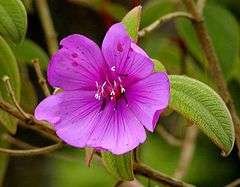Tibouchina
| Tibouchina | |
|---|---|
 | |
| Tibouchina semidecandra at Strybing Arboretum, San Francisco | |
| Scientific classification | |
| Kingdom: | Plantae |
| (unranked): | Angiosperms |
| (unranked): | Eudicots |
| (unranked): | Rosids |
| Order: | Myrtales |
| Family: | Melastomataceae |
| Genus: | Tibouchina Aubl. |
| Species | |
|
About 350; see text. | |
| Synonyms | |
|
Lasiandra DC. | |
Tibouchina /ˌtɪbuːˈkaɪnə/[1][2] is a genus of about 350 species of neotropical plants in the family Melastomataceae. They are trees, shrubs or subshrubs growing 0.5–25 m tall, and are known as glory bushes or glory trees. They are native to rainforests of Mexico, the Caribbean, and South America, especially Brazil. There is one Australian. The name comes from an adaptation of a term for a member of this genus in an indigenous language of the Guianas.[2]
Selected species
|
|
Cultivation

Several species are cultivated for their large bright flowers. As tropical plants they are rather cold-sensitive, and should be raised in a greenhouse wherever temperatures fall below 8 °C to 10 °C.
One species, Tibouchina lepidota 'Alstonville', known for its brilliant display of flowers in late summer and autumn is common in many parts of Australia. In Australia, both this species and Tibouchina grandiflora and cultivars are commonly known as Lasiandra. They are closely related to a native shrub Melastoma affine also known as Native Lasiandra. All these plants are featured and celebrated in the annual Lasiandra Festival** held in the small country town of Wauchope, which is situated in the hinterland of the Central New South Wales Coast, City of Port Macquarie. Bright purple, the colour of the flowers forms the central theme of the festival. http://www.lasiandrafestival.com.au/
Invasive potential
All Tibouchina species are considered noxious weeds in Hawaii[3] because of their high potential for being invasive species.[4][5][6]
References
- ↑ Sunset Western Garden Book, 1995:606–607
- 1 2 "Tibouchina." Webster's Third New International Dictionary of the English Language, Unabridged. Merriam Webster, 1961.
- ↑ Hawaii Administrative Rules, Title 4 Department of Agriculture, Subtitle 6 Division of Plant Industry, Chapter 68, Noxious Weed Rules (http://www.hawaiiag.org/hdoa/adminrules/AR-68.pdf, cited 5 February 2007)
- ↑ Tibouchina urvilleana: Pacific Island Ecosystems at Risk project [PIER] data (http://www.hear.org/pier/species/tibouchina_herbacea.htm, accessed 5 February 2007)
- ↑ Plants of Hawaii reports: Tibouchina longifolia (http://www.hear.org/starr/hiplants/reports/html/tibouchina_longifolia.htm, accessed 5 February 2007)
- ↑ Plants of Hawaii reports: Tibouchina urvilleana (http://www.hear.org/starr/hiplants/reports/html/tibouchina_urvilleana.htm, accessed 5 February 2007)
External links
| Wikimedia Commons has media related to Tibouchina. |
| Wikispecies has information related to: Tibouchina |